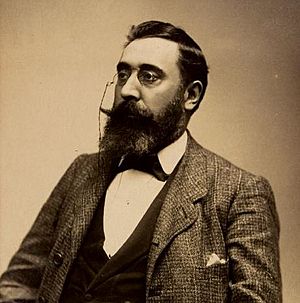Manuel Curros Enríquez facts for kids
Manuel Curros Enríquez (born September 15, 1851 – died February 7, 1908) was an important writer and journalist from Galicia, Spain. He wrote in the Galician language. Many people see him as a key figure in Galician culture and identity.
Early Life and Studies
Manuel Curros Enríquez was born in Celanova, Galicia, Spain. His father was a scriban, which means he copied important documents. Manuel went to school, but he later had to help his father with his work.
When he was sixteen, Manuel left home. He went to live with some relatives and eventually moved to Madrid. There, he lived with his brother Ricardo. In Madrid, Manuel had the chance to continue his education. He even started studying law at university, but he did not finish his degree.
While he was still a law student, Manuel began writing and publishing poems in Galician. One of his poems, "Cantiga," was later set to music. Today, it is a well-known Galician song.
Writing and Journalism
After a big change in Spain in September 1868, Curros became interested in democratic ideas. He then started his career as a writer. In 1871, he began living with Modesta Luisa Polonia Vázquez Rodríguez. They had a son in 1873 and got married in 1877.
In 1877, Curros won a prize in Ourense for his poem A Virxe do Cristal. This made him known as an important Galician poet. He then moved to Ourense and continued his writing.
In 1880, he published a book of poems called Aires da miña terra. This book became very popular. However, the bishop of Orense, Cesáreo Rodríguez, did not like it. He said the book contained ideas against the church. The book was ordered to be removed from sale, but Curros was later found innocent. This event made his book even more famous, and it sold out quickly.
Aires da miña terra came out in the same year as Rosalia de Castro's Follas Novas. Both books helped to bring back Galician literature after many years of silence. After losing his job, Curros returned to Madrid in 1883. He started working for a newspaper called El Porvenir (The Future).
In 1888, he published O Divino Sainete. This was a funny story that made fun of Dante's Divine Comedy and some religious ideas of the time. He also wrote many articles in Spanish for important newspapers like El Imparcial.
Life in Cuba
In 1894, Manuel Curros Enríquez moved to Havana, Cuba. People there welcomed him warmly. He even had the chance to start his own newspaper, La Tierra Gallega (The Galician Land). However, this newspaper did not last long.
Curros then joined the team of another newspaper, El Diario de las Familias (Journal of the Families). In this role, he supported people who wanted more self-rule for Cuba. This did not make him popular with the local government or some other Galicians living there.
He returned to A Coruña, Spain, in 1904. People who supported regionalism (strong local identity) were happy to see him. But he soon went back to Havana to work for another newspaper, Diario de la Marina.
Manuel Curros Enríquez became very ill in 1908. He passed away on February 7, 1908, in Havana. His body was later sent back to Galicia.
Works
- A Virxe do Cristal (1877)
- Aires da miña terra (1880)
- O divino sainete (1888)
See also
 In Spanish: Manuel Curros Enríquez para niños
In Spanish: Manuel Curros Enríquez para niños
- Plaza de Curros Enríquez


